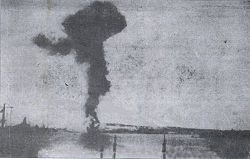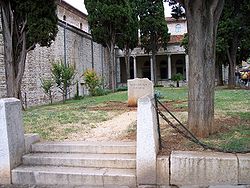
Vergarolla explosion
Encyclopedia


Pula
Pula is the largest city in Istria County, Croatia, situated at the southern tip of the Istria peninsula, with a population of 62,080 .Like the rest of the region, it is known for its mild climate, smooth sea, and unspoiled nature. The city has a long tradition of winemaking, fishing,...
, which was at the time under temporary Allied
Allies of World War II
The Allies of World War II were the countries that opposed the Axis powers during the Second World War . Former Axis states contributing to the Allied victory are not considered Allied states...
military administration.
The ordnance, which "had been swept from the water [and] were piled up on a beach awaiting disposal" exploded at just after 2pm, 18 August 1946. Initial newspaper reports cited 43 dead and 57 injured, including two British soldiers.
Many of the victims were bathers who were attending an annual swimming event called Scarioni Cup. The event had strong political implications, because local Italian leaders and the main Italian newspaper L'Arena di Pola, suggested that it was a demonstration of the Italian feelings of the residents, and a way to contrast the possible annexation to the Socialist Federal Republic of Yugoslavia
Socialist Federal Republic of Yugoslavia
The Socialist Federal Republic of Yugoslavia was the Yugoslav state that existed from the abolition of the Yugoslav monarchy until it was dissolved in 1992 amid the Yugoslav Wars. It was a socialist state and a federation made up of six socialist republics: Bosnia and Herzegovina, Croatia,...
. .
The exact number of victims of the incident remains undefined, with estimates ranging up to about a hundred dead.
Allied investigation
A subsequent Allied military investigation into the incident was undertaken by Brigadier M.D. Erskine, commander of the 24th Guards Brigade who reported on 8 September 1946 that the accident was caused by the detonation of three torpedoTorpedo
The modern torpedo is a self-propelled missile weapon with an explosive warhead, launched above or below the water surface, propelled underwater towards a target, and designed to detonate either on contact with it or in proximity to it.The term torpedo was originally employed for...
warheads, four TNT demolition charges and five smoke generators. He said that the munitions had been inspected on several occasions and had been certified as being safe and that "I do not consider therefore that it is possible for it to have exploded without being detonated". He added that "[t]he ammunition was deliberately exploded by person or persons unknown. This is confirmed by the fact that a small preliminary explosion was heard and a fire was seen burning".
Agreeing with these findings, Brigadier Bastin on behalf of the General Officer Commanding in Chief concluded in the final report dated 14 February 1947 that "I am of the opinion that the explosion was caused by some person or persons unknown. I am satisfied that the ammunition was safe and properly inspected and that it was not feasible to place guards over it. I therefore consider that no blame for the explosion lies with the Allied Military Authorities".

